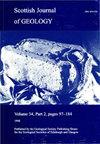苏格兰西北部盖尔洛克剪切带伪岩记录的各向异性角闪岩破裂几何形状
IF 0.5
4区 地球科学
Q4 GEOLOGY
引用次数: 4
摘要
最近涉及复杂多断层断裂的地震增加了我们对同震滑动短时间内发生的各种断裂几何形状和断层相互作用的认识。几何复杂性与空间不均匀的滑移和应力降分布有着内在的联系,因此需要纳入地震危险性分析。对折返古断层带的研究有助于在发震深度的岩性和结构背景下研究断裂过程。在苏格兰西北部的盖尔洛克剪切带中,叶理角闪岩含有假快速液,记录了古代低震级(≤MW 3)地震活动的破裂几何形状。假快速液断层通常与叶理平行,这表明叶理平面是地震破裂的薄弱界面。断层分割、阶跃、分支和角砾岩扩张体积引入了不一致性和复杂性。假快速电解质的几何形状表明,滑移成核在几个平行的叶理平面上同时开始,间距为毫米和厘米,导致在一次地震中相邻节段和分支的渐进相互作用和最终连接。与这种结构控制相互作用的是,丰富的低不平衡熔点角闪石的岩性影响促进了同震熔融,相对较高的同震熔融压力促进了瞬态扩张位点。这些断层阐明了可能升级为大型活动断层带的控制和过程,这些活动断层带承载着重大地震活动。补充材料:补充图1和图2分别是图4a和图5中显示的现场照片的未注释版本,可在https://doi.org/10.6084/m9.figshare.c.4573256主题集:本文是SJG早期职业研究集的一部分,可在以下网站获取:https://www.lyellcollection.org/cc/SJG-early-career-research本文章由计算机程序翻译,如有差异,请以英文原文为准。
Rupture geometries in anisotropic amphibolite recorded by pseudotachylytes in the Gairloch Shear Zone, NW Scotland
Recent earthquakes involving complex multi-fault rupture have increased our appreciation of the variety of rupture geometries and fault interactions that occur within the short duration of coseismic slip. Geometrical complexities are intrinsically linked with spatially heterogeneous slip and stress drop distributions, and hence need incorporating into seismic hazard analysis. Studies of exhumed ancient fault zones facilitate investigation of rupture processes in the context of lithology and structure at seismogenic depths. In the Gairloch Shear Zone, NW Scotland, foliated amphibolites host pseudotachylytes that record rupture geometries of ancient low-magnitude (≤MW 3) seismicity. Pseudotachylyte faults are commonly foliation parallel, indicating exploitation of foliation planes as weak interfaces for seismic rupture. Discordance and complexity are introduced by fault segmentation, stepovers, branching and brecciated dilational volumes. Pseudotachylyte geometries indicate that slip nucleation initiated simultaneously across several parallel foliation planes with millimetre and centimetre separations, leading to progressive interaction and ultimately linkage of adjacent segments and branches within a single earthquake. Interacting with this structural control, a lithological influence of abundant low disequilibrium melting-point amphibole facilitated coseismic melting, with relatively high coseismic melt pressure encouraging transient dilational sites. These faults elucidate controls and processes that may upscale to large active fault zones hosting major earthquake activity. Supplementary material: Supplementary Figures 1 and 2, unannotated versions of field photographs displayed in Figures 4a and 5 respectively, are available at https://doi.org/10.6084/m9.figshare.c.4573256 Thematic collection: This article is part of the SJG Collection on Early-Career Research available at: https://www.lyellcollection.org/cc/SJG-early-career-research
求助全文
通过发布文献求助,成功后即可免费获取论文全文。
去求助
来源期刊

Scottish Journal of Geology
地学-地质学
CiteScore
1.70
自引率
0.00%
发文量
10
审稿时长
>12 weeks
期刊介绍:
Although published only since 1965, the Scottish Journal of Geology has a long pedigree. It is the joint publication of the Geological Society of Glasgow and the Edinburgh Geological Society, which prior to 1965 published separate Transactions: from 1860 in the case of Glasgow and 1863 for Edinburgh.
Traditionally, the Journal has acted as the focus for papers on all aspects of Scottish geology and its contiguous areas, including the surrounding seas. The publication policy has always been outward looking, with the Editors encouraging review papers and papers on broader aspects of the Earth sciences that cannot be discussed solely in terms of Scottish geology.
The diverse geology of Scotland continues to provide an important natural laboratory for the study of earth sciences; many seminal studies in geology have been carried out on Scottish rocks, and over the years the results of much of this work had been published in the Journal and its predecessors.
The Journal fully deserves its high reputation worldwide and intends to maintain its status in the front rank of publications in the Earth sciences.
 求助内容:
求助内容: 应助结果提醒方式:
应助结果提醒方式:


